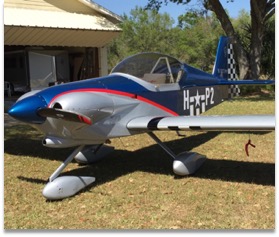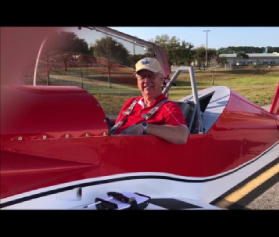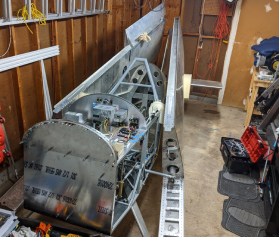Bob Metcalfe is from Flint Hill, VA and has Panther LS SN116. Bob has been flying his Panther since Nov of 2021. Bob sent over the below information about his build experience to share. Congrats again Bob! Beautiful aircraft and a great write-up.
Bob Metcalfe's Panther Building Log
This project started around Thanksgiving 2019 when I ordered the first parts of my kit from SPA (Sport Performance Aviation) out of Green Cove Springs, Florida. I ordered partial kits with the tail feathers, ailerons, flaps, and aft fuselage parts first. I elected to have the factory build the wing spar, fuel tanks, the canopy, and drill the holes in the tail wheel strut. The second shipment would be the wings, and the 3rd shipment would encompass the forward fuselage cage, canopy, and all fiberglass preformed parts.
I put the building manual on my computer and all phases of this build are depicted by photos in order of accomplishment. The total hours of the build were about 1100 hours not including painting which was done at a commercial paint shop in Front Royal, VA. First delivery: Feb, 2020 – tail feathers and aft fuselage were delivered.
Work started in my garage doing the elevators first followed by the horizontal stabilizer, rudder, and vertical stabilizer. The hard part for me was getting the hinges attached properly, but in the end was a success.
REAR FUSELAGE
Starting in March 2020 the tail feathers and ailerons were complete, so I started on the rear fuselage. This process was straightforward, building the bulkheads first and then attaching the skins after drilling, de-burring, and dimpling. The building manual and plans were easy to comprehend, so this process moved on easily. Putting the tail feathers in place gave the impression of a real airplane. This part of the construction was completed in early May of 2020. I elected to use flush rivets on everything except for the forward fuselage as I did not want to compromise the square steel cage with dimples. Wings were delivered in May 2020 which started the next phase of construction.
WING CONSTRUCTION: May 2020 - July 2020
This phase took longer than the other activities up to this point. Jigs had to be built in the garage and sorting out all the parts in order took a lot of time as all looked alike. Thank God for the numbering system of the parts by SPA. Measuring for square and level on the jig was a challenge. I am glad I had the factory build the main spars and fuel tanks as it would have increased my building time a few months.
I had to cut off one foot on each wing to make the aircraft a “Sport” model plus also had to cut off one foot on each flap. Didn’t know this until these items were built.
Forward Fuselage & Finish Kit: Jul 2020 - Oct 2021
After the wings were done and fuel tanks fitted to wings it was time to mate the rear and forward fuselage and then fill the cockpit with all remaining equipment including gear, rudder pedals, wheels & brakes, seat, flap control, instrument panel, electric system, throttle quadrant, fuel lines, fuel pump, and lots of other misc equipment. Also the canopy frame was built and mated to the canopy and the airframe. This alone took about three weeks to figure out and accomplish. After doing this, it didn’t look as complicated as it seemed during the build. The builder’s manual put these activities in the correct order of installment. As depicted in the above dates this activity required the most time so far – the left forward skin was finally riveted on in the latter part of Sept 2021.
The cowling fitting was the most difficult so far. The top cowling was fit, but determined to have been cut too much at the bottom juncture and had to be replaced by the factory and fitted again – this time correctly. Also, the canopy fiberglass fit around the front and rear had to be molded to fit. This also was easier than anticipated.
After fitting all equipment in the fuselage it was time to fit the wings and tail feathers and install the engine. Adjusting the wings was not easy and I determined to not install the wing folding equipment as I would not need this function. Flaps and ailerons were attached and adjusted. Bolting on the tail feathers proved difficult and while adjusting the correct angle displacement it was determined that I had set incorrectly the angle of incidence for the horizontal stabilizer. This was corrected with advice from the SPA factory. Also, the elevators showed too much warp and had to be discarded and built again. All this plus fitting the new top cowling consumed about two months.
The engine builder, Tom Sweitz, bolted on the engine Sep 2021 and it was my job to fit equipment and accessories to it including throttle body, oil cooler, exhaust cuffs, cables, electric hookups, and baffling. Since the wings were fitted, the strip around the wing that meets the fuselage had to be fit – so the wings were removed to do this function. Also since the wings were off, I determined that now was time to get them painted.
Final steps to finish Panther from late Oct 2021 - Nov 2021
A lot of adjustments and final touches were done after the plane was returned from the paint shop. This was started by riveting on all the fiberglass wing and tail tips along with installing the nav/strobe lights. The brake reservoir and lines were serviced and no leaks observed. The flaps and flight controls had their final adjustment.
Sealing the baffling, clean up wiring bundles, adjusting canopy emergency release pins, adjusting seat and seat belts, marking instruments, operating equipment, tightening stop nuts on all controls & cables – all of the above took a lot of time without seeing much progress (about two weeks).
The engine I chose for the project is a Lycoming IO-320, a fuel-injected engine with Lycoming O-340 cylinders and crankshaft. This power plant develops approximately 170 plus horsepower, Next was to make the engine operational by wiring mags, and connecting scat hoses to the oil cooler and cabin heater. Connecting the mixture cable to get full travel at the throttle body was a chore but finally done calling for some engineering magic. One problem developed on the first engine run – the right mag was inoperative which was found to be grounded at both the switch and the mag. This was corrected and the next engine run was smooth with all systems running as required. No fuel or oil leaks were found. All engine gages, fuel gages, and radios/nav checked out nicely.
The 3rd engine run also incorporated taxi time – slow taxi. The plane steers very nicely and has good visibility and the brakes are smooth. I ran the engine up to 2000 rpm which produced enough power that strained me holding the brakes, so the next run will be with the tail wheel tied to the back of my truck so I can check for max static RPM.
Each aircraft registered in the United States is required to have a specific identification number displayed on the aircraft plus have an airworthy certificate to designate that the plane is safe to fly. The FAA or a designated representative would do this inspection. My registration number was chosen by me (N958VT) and represents my graduation year from VPI (Va Tech),1958, which also was my 1st solo date in a Piper J-3 Cub.
On 19 Nov 2021, my Panther Sport N958VT was issued this airworthy certificate which enabled me to start the 40-hour phase 1 testing. A specific geographical area was assigned for this testing. and when this testing was complete, I would be free to fly in the USA as I pleased.
The testing time was spent determining how the airplane would respond to control inputs in all phases of flight. The manufacturer and designer of the original Panther Sport, SPA (Sport Performance Aviation), had gone through this process, and flying qualities were known. But, each plane built from this manufactures kit could have different flying characteristics depending how close the plans and building manual were followed and the skill level of the builder. I did not deviate from the blueprints or plans, therefore, I expected very similar results in the actual performance of my plane. As expected, my results were in line with the manufacture of the kit. I was well pleased, to say the least.
With approximately 170 plus horsepower, This makes this plane a real “Hot Rod” in my opinion. The propeller is a three-bladed Sensenich ground adjustable. I have the pitch adjustment to the max cruise position which gives better climb performance than expected plus a very decent cruise speed. I get around 2500 feet/min climb at 140 mph, and can indicate slightly more than 200 mph airspeed at 3000 feet.
Flying this Panther Sport is a blast. I feel the plane is glued to my body and all I have to do is think of the maneuver and it responds. Formation, in my opinion, is extremely easy because of the positive response to slight engine or control movement. My “RV” friends are jealous as I can outclimb and cruise with them easily. At the time of this writing, I have completed the 40-hour test requirement and have just finished the 1st year condition inspection. Design and Kit well-done SPA.



